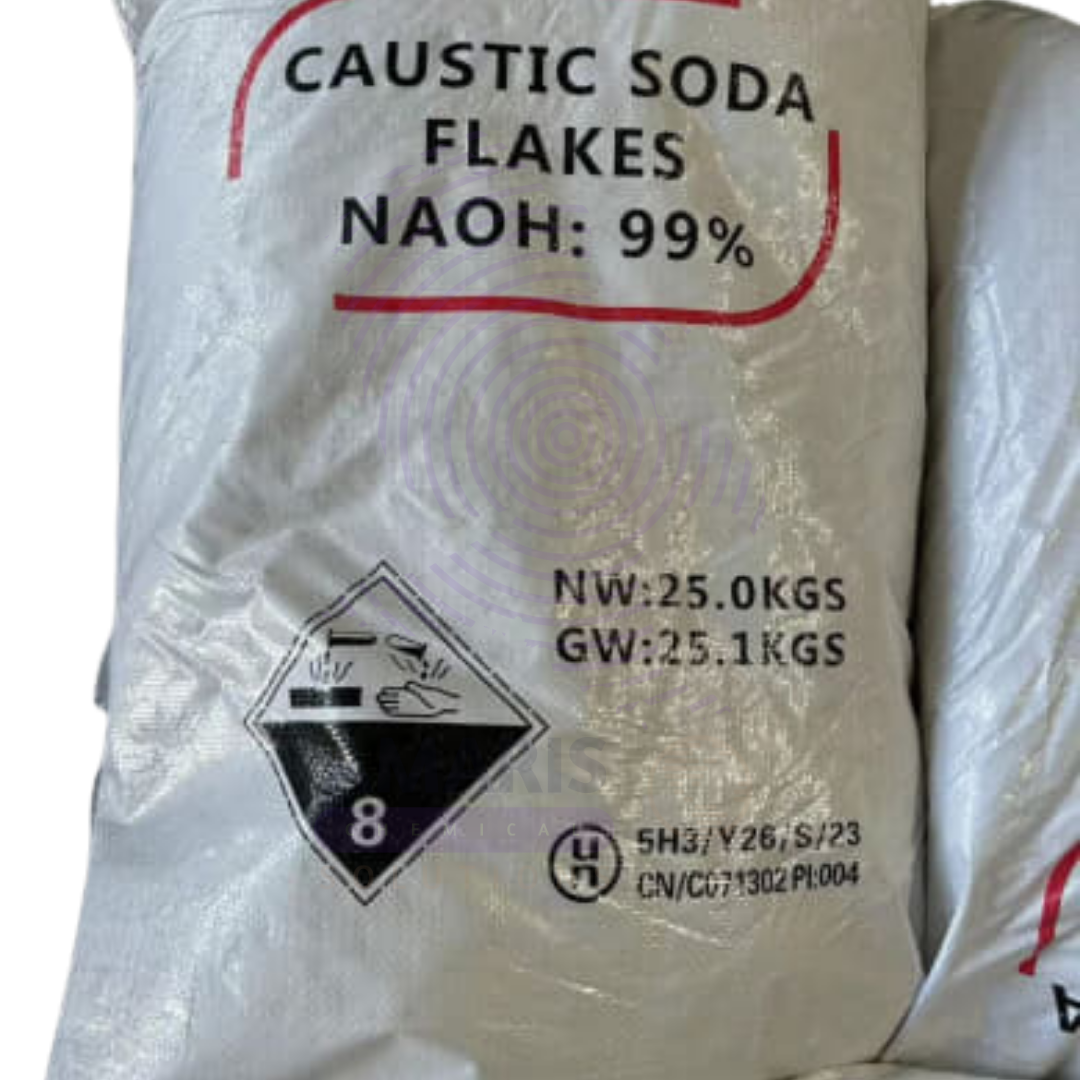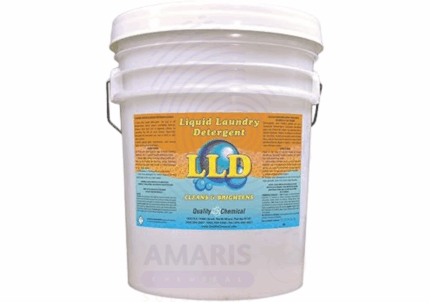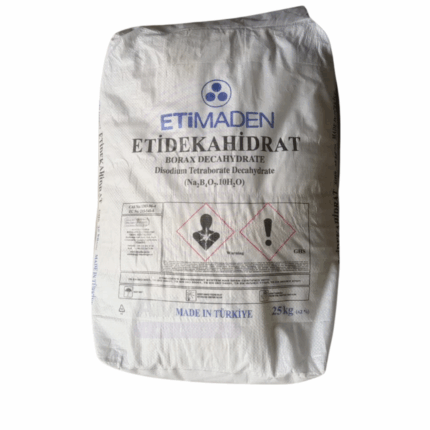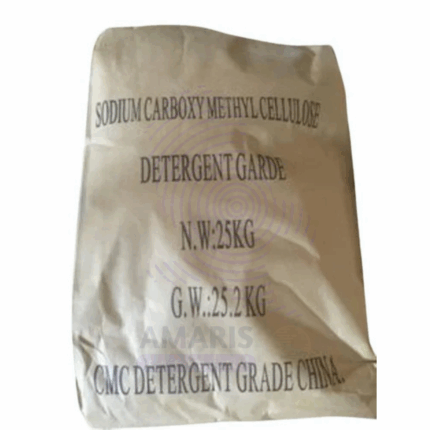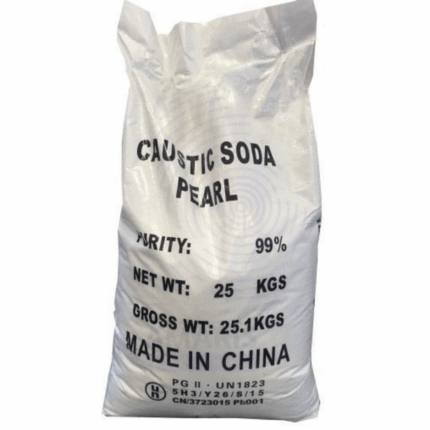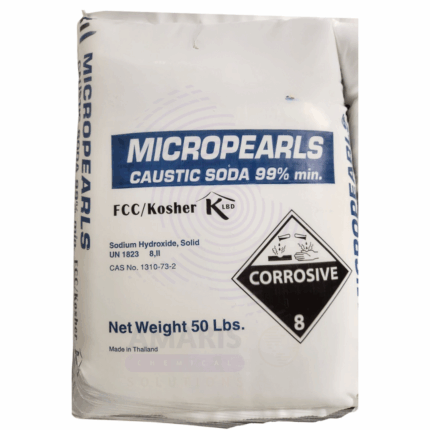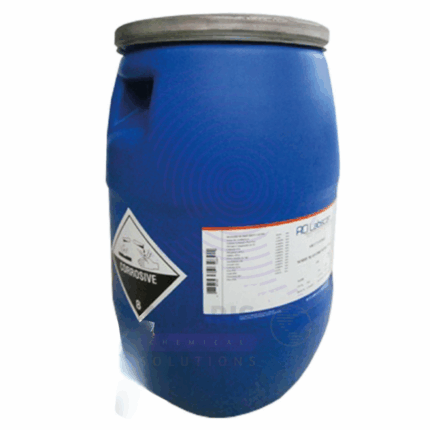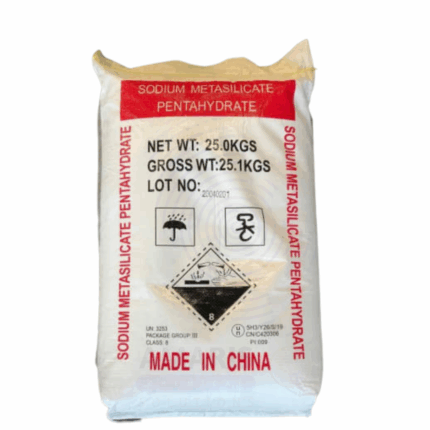
Caustic Soda Flakes (Sodium Hydroxide)
$ 1.65 Original price was: $ 1.65.$ 1.55Current price is: $ 1.55.
Caustic Soda Flakes, also known as Sodium Hydroxide Flakes (NaOH), are a highly alkaline, white, solid substance that is crystalline and flaky in form. Produced by evaporating aqueous sodium hydroxide solutions, these flakes are highly soluble in water and exhibit strong corrosive properties. Caustic Soda Flakes are widely used in a variety of industrial, chemical, and manufacturing processes due to their strong alkalinity, ability to saponify fats, and effectiveness in pH adjustment. Their high purity and ease of handling in flake form make them suitable for use in chemical synthesis, pulp and paper production, water treatment, and detergent manufacturing.
Caustic Soda Flakes (Sodium Hydroxide)
Primary Uses
- Chemical Industry
- Used as a fundamental raw material in the manufacture of soaps, detergents, and cleaning agents by saponifying fats and oils.
- Serves as a critical reactant in the production of chemicals such as sodium hypochlorite, sodium phosphate, and various sodium salts.
- Utilized in pH regulation and neutralization processes across many chemical manufacturing operations.
- Pulp and Paper Industry
- Employed in the pulping process to break down lignin and separate cellulose fibers, aiding in paper production.
- Used in bleaching and chemical recovery processes to improve paper quality and efficiency.
- Water Treatment
- Adjusts and controls pH in municipal and industrial wastewater treatment plants.
- Aids in the removal of heavy metals and neutralization of acidic wastes.
- Detergents & Cleaning Products
- Acts as a powerful cleaning and degreasing agent in industrial and household detergent formulations.
- Used in drain cleaners and oven cleaners for its ability to dissolve organic matter and fats.
Secondary Uses
- Food Industry
- Used as a food additive (E524) in controlled amounts as a pH regulator and peeling agent for fruits and vegetables, e.g., in the processing of olives and cocoa.
- Employed in the production of caramel color and in refining edible oils.
- Textile Industry
- Utilized in the mercerization process to treat cotton fibers, improving dye uptake, strength, and luster.
- Petroleum Industry
- Used in refining crude oil and neutralizing acidic components.
- Aluminum Production
- Applied in the Bayer process for extracting alumina from bauxite ore.
1. Basic Identification Attributes
- Chemical Name (IUPAC): Sodium hydroxide
- Common/Trade Name: Caustic Soda Flakes
- CAS Number: 1310-73-2
- HS Code: 2815.12.00
- Molecular Formula: NaOH
- Synonyms:
- Sodium Hydroxide Flakes
- Lye Flakes
- Caustic Soda
2. Physical & Chemical Properties
- Physical State: Solid flakes
- Color & Odor: White; odorless
- Melting Point: 318°C (604°F)
- Boiling Point: Decomposes before boiling
- Density: ~2.13 g/cm³ (solid)
- Solubility:
- Highly soluble in water (exothermic dissolution)
- Insoluble in organic solvents
- pH (1% aqueous solution): Approximately 14 (strongly alkaline)
- Stability: Stable under dry conditions; reacts vigorously with water and acids
3. Safety & Hazard Attributes
- Hazard Class (GHS): Skin corrosion/irritation (Category 1A)
- NFPA Ratings:
- Health: 3
- Flammability: 0
- Reactivity: 1
- Exposure Limits: OSHA PEL: 2 mg/m³ (ceiling)
- Toxicity: Corrosive; causes severe burns on contact with skin or eyes
- Reactivity: Highly reactive with acids, water, and some metals; exothermic reaction with water
4. Storage & Handling Attributes
- Storage Conditions: Store in a cool, dry, well-ventilated area, away from moisture and incompatible substances (e.g., acids, organic materials).
- Container Type: Corrosion-resistant containers such as polyethylene drums or coated steel drums.
- Shelf Life: Indefinite if stored properly (dry and sealed).
- Special Handling: Use full PPE; handle with care to avoid contact and inhalation of dust or mist.
5. Regulatory & Compliance Attributes
- FDA Status: Approved as a food additive (E524) under strict conditions
- REACH Status: Registered
- Transportation: Classified as a hazardous material (UN1823 or UN1824 depending on form)
- Waste Disposal: Dispose of according to local hazardous waste regulations; neutralize before disposal.
6. Environmental & Health Impact
- Ecotoxicity: Highly toxic to aquatic life due to high pH; must be neutralized before discharge.
- Persistence: Does not bioaccumulate; rapidly neutralizes in the environment.
- Bioaccumulation: Not applicable
- Carcinogenicity/Mutagenicity: Not classified as carcinogenic or mutagenic
- Biodegradability: Not biodegradable (inorganic chemical)
Safety Handling Precautions
Personal Protective Equipment (PPE):
- Chemical-resistant gloves (e.g., neoprene, nitrile)
- Protective goggles or face shield
- Long-sleeved protective clothing
- Respiratory protection when dust or mist is present
Handling Measures:
- Avoid inhalation of dust and contact with skin and eyes
- Use in well-ventilated areas
- Keep away from acids and incompatible materials
Storage Measures:
- Keep containers tightly sealed
- Store in dry conditions to prevent caking and reaction with moisture
- Implement spill containment procedures
Hygiene Practices:
- Wash hands and exposed skin thoroughly after handling
- Do not eat, drink, or smoke in the work area
First Aid Measures
- Inhalation: Move to fresh air immediately; seek medical attention if symptoms occur.
- Skin Contact: Rinse immediately with copious water for at least 15 minutes; remove contaminated clothing; seek urgent medical care.
- Eye Contact: Flush eyes with water continuously for at least 15 minutes; seek immediate medical attention.
- Ingestion: Do not induce vomiting; rinse mouth and seek immediate medical help.
Firefighting Measures
- Fire Hazards: Non-flammable, but reacts violently with water and acids generating heat.
- Extinguishing Media: Use dry chemical, CO₂, or foam on adjacent fires; do not use water directly on caustic soda to avoid violent reaction.
- Special Precautions: Firefighters should wear full protective gear and self-contained breathing apparatus.
- Decomposition Products: May release toxic fumes of sodium oxides and hydrogen gas when in contact with metals.


 Preservatives(food)
Preservatives(food) Flavor Enhancers
Flavor Enhancers Acidulants
Acidulants Sweeteners
Sweeteners Antioxidants
Antioxidants Colorants(food)
Colorants(food) Nutraceutical Ingredients (food)
Nutraceutical Ingredients (food) Nutrient Supplements
Nutrient Supplements Emulsifiers
Emulsifiers
 Collectors
Collectors Dust Suppressants
Dust Suppressants Explosives and Blasting Agents
Explosives and Blasting Agents Flocculants and Coagulants
Flocculants and Coagulants Frothers
Frothers Leaching Agents
Leaching Agents pH Modifiers
pH Modifiers Precious Metal Extraction Agents
Precious Metal Extraction Agents
 Antioxidants(plastic)
Antioxidants(plastic) Colorants (Pigments, Dyes)
Colorants (Pigments, Dyes) Fillers and Reinforcements
Fillers and Reinforcements Flame Retardants
Flame Retardants Monomers
Monomers Plasticizers
Plasticizers Polymerization Initiators
Polymerization Initiators Stabilizers (UV, Heat)
Stabilizers (UV, Heat)
 Antifoaming Agents
Antifoaming Agents Chelating Agents
Chelating Agents Coagulants and Flocculants
Coagulants and Flocculants Corrosion Inhibitors
Corrosion Inhibitors Disinfectants and Biocides
Disinfectants and Biocides Oxidizing Agents
Oxidizing Agents pH Adjusters
pH Adjusters Scale Inhibitors( water)
Scale Inhibitors( water)
 Antioxidants(cosmetic)
Antioxidants(cosmetic) Emollients
Emollients Fragrances and Essential Oils
Fragrances and Essential Oils Humectants
Humectants Preservatives
Preservatives Surfactants(cosmetic)
Surfactants(cosmetic) Thickeners
Thickeners UV Filters
UV Filters
 Fertilizers
Fertilizers Soil Conditioners
Soil Conditioners Plant Growth Regulators
Plant Growth Regulators Animal Feed Additives
Animal Feed Additives Biostimulants
Biostimulants Pesticides (Herbicides, Insecticides, Fungicides)
Pesticides (Herbicides, Insecticides, Fungicides)
 Active Pharmaceutical Ingredients (APIs)
Active Pharmaceutical Ingredients (APIs) Excipients
Excipients Solvents(pharmaceutical)
Solvents(pharmaceutical) Antibiotics
Antibiotics Antiseptics and Disinfectants
Antiseptics and Disinfectants Vaccine Adjuvants
Vaccine Adjuvants Nutraceutical Ingredients (pharmaceutical)
Nutraceutical Ingredients (pharmaceutical) Analgesics & Antipyretics
Analgesics & Antipyretics
 Analytical Reagents
Analytical Reagents Solvents(lab)
Solvents(lab) Chromatography Chemicals
Chromatography Chemicals Spectroscopy Reagents
Spectroscopy Reagents microbiology-and-cell-culture-reagents
microbiology-and-cell-culture-reagents Molecular Biology Reagents
Molecular Biology Reagents Biochemical Reagents
Biochemical Reagents Inorganic and Organic Standards
Inorganic and Organic Standards Laboratory Safety Chemicals
Laboratory Safety Chemicals Specialty Laboratory Chemicals(Special Laboratory Equipment)
Specialty Laboratory Chemicals(Special Laboratory Equipment)
 Demulsifiers
Demulsifiers Hydraulic Fracturing Fluids
Hydraulic Fracturing Fluids Scale Inhibitors(oil)
Scale Inhibitors(oil) Surfactants(oil)
Surfactants(oil) Drilling Fluids
Drilling Fluids
 Dyes and Pigments
Dyes and Pigments Bleaching Agents
Bleaching Agents Softening Agents
Softening Agents Finishing Agents
Finishing Agents Antistatic Agents
Antistatic Agents
 Admixtures
Admixtures Waterproofing Agents
Waterproofing Agents Sealants and Adhesives
Sealants and Adhesives Curing Compounds
Curing Compounds Concrete Repair Chemicals
Concrete Repair Chemicals Anti-Corrosion Coatings
Anti-Corrosion Coatings
 Surfactants(cleaning)
Surfactants(cleaning) Builders
Builders Enzymes
Enzymes Solvents (Cleaning)
Solvents (Cleaning) Fragrances
Fragrances
 Electronic Chemicals
Electronic Chemicals Catalysts
Catalysts Lubricants
Lubricants Photographic Chemicals
Photographic Chemicals Refrigerants
Refrigerants Automotive chemicals
Automotive chemicals Pyrotechnic Chemicals
Pyrotechnic Chemicals
 Biodegradable Surfactants
Biodegradable Surfactants Bio-based Solvents
Bio-based Solvents Renewable Polymers
Renewable Polymers Carbon Capture Chemicals
Carbon Capture Chemicals Wastewater Treatment Chemicals
Wastewater Treatment Chemicals
 Pigments
Pigments Solvents(paint)
Solvents(paint) Specialty Coatings
Specialty Coatings Binders/Resins
Binders/Resins Additives
Additives Driers
Driers Anti-Corrosion Agents
Anti-Corrosion Agents Functional Coatings
Functional Coatings Application-Specific Coatings
Application-Specific Coatings
 Fresh Herbs
Fresh Herbs Ground Spices
Ground Spices Whole Spices
Whole Spices Spice Blends
Spice Blends Dried Herbs
Dried Herbs
 Leavening Agents
Leavening Agents Dough Conditioners
Dough Conditioners Flour Treatments
Flour Treatments Fat Replacers
Fat Replacers Decoratives
Decoratives Preservatives(baking)
Preservatives(baking)
 Plasticizers & Softeners
Plasticizers & Softeners Reinforcing Agents
Reinforcing Agents Adhesion Promoters
Adhesion Promoters Vulcanizing Agents
Vulcanizing Agents Antidegradants
Antidegradants Blowing Agents
Blowing Agents Fillers & Extenders
Fillers & Extenders Accelerators & Retarders
Accelerators & Retarders